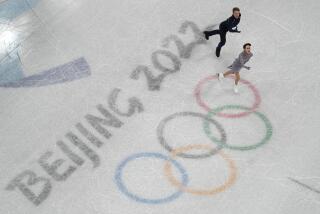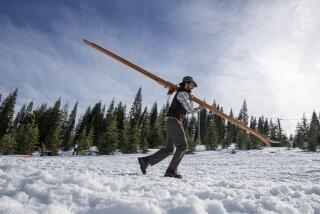With So Much at Stake, Mustard Is Off Hotdog : Terminology: In quest for legitimacy and an Olympic berth, ballet skiing searches for a name that fits.
- Share via
What’s in a name?
Plenty, if your sport is ballet skiing and the tendency is to write you off along with rhythmic gymnastics and synchronized swimming, exercises that accent grace and are generally eschewed by spectators who would rather be entertained by things more athletically demanding.
In its infancy the sport, basically an American creation, was called hotdogging.
“Then they changed the name to ‘freestyle’ to make it sound more professional and less hippie-ish,” says Ellen Breen.
Also under that freestyle umbrella fell aerials and moguls, disciplines no more spectacular than ballet skiing and demanding an athleticism no greater than that of their sister sport.
Aerials and moguls are now solidly ensconced as medal events in the Winter Games. Ballet skiing is not. Any wonder?
The rules changed, too, as the sport’s panjandrums tinkered, taking much of the spontaneity out of it and replacing interpretation with yawn-inducing compulsories.
“It was just plain boring,” said eight-time World Cup ski ballet champion Jan Brewer Carmichael, who stopped competing in 1991.
Soon after Carmichael quit, the pendulum swung again, back toward a ground on which Breen felt comfortable, one that equally rewarded difficult maneuvers and individual renderings of musical accompaniment.
“Over the years they’d been taking the athleticism out of the event, and the sport stagnated,” said Breen. “But then they woke up and took out a lot of compulsories. It’s a good mix right now.”
Breen’s career blossomed in the new environment. She won the World Championship in 1991 and again in 1993, and is undefeated in seven World Cup events of the 1994-95 season.
But ballet skiing--easy on the ballet--has languished after reaching the Olympic doorstep. It was a demonstration sport in the Winter Games of 1988 at Calgary, Can., and again in 1992 in Albertville, France. It has advanced no further.
All three freestyle disciplines have closed ranks in the push for Olympic recognition.
They’ve taken to wearing armbands at competitions with the letters BAM (an acronym for ballet, aerials and moguls) superimposed over the Olympic rings. Though the groundswell originated in the United States, other countries have joined, as well as other ski sports.
“The Federation of International Skiing is pushing it too,” said Breen. “I’d say it really looks good for us in 2002, especially if Salt Lake City gets the Winter Games.”
But first there’s that little matter of re-labeling and the subsequent disassociation from other “sports” with less-than-positive images.
Ballet skiing summons a visualization more of tutus, entrechats and pirouettes than downhill swoops and dips and daring 720-degree spins on a couple of long thin sticks.
Considering the many millions the networks have been willing to shower upon the Games in exchange for television rights, and the ease with which this compact, dynamic sport can be commercially packaged for the medium, the feeling persists that ballet skiing is merely a name-change away from becoming a full-blown Olympic sport.
Says Breen: “I hear talk about it being renamed acro-skiing. I hope so. If we’re going to get the big crowds, especially in the United States, it’s a necessity. We’ve got the athleticism. We’ve just got to get people out of thinking it’s some kind of dance event.”
More to Read
Go beyond the scoreboard
Get the latest on L.A.'s teams in the daily Sports Report newsletter.
You may occasionally receive promotional content from the Los Angeles Times.






